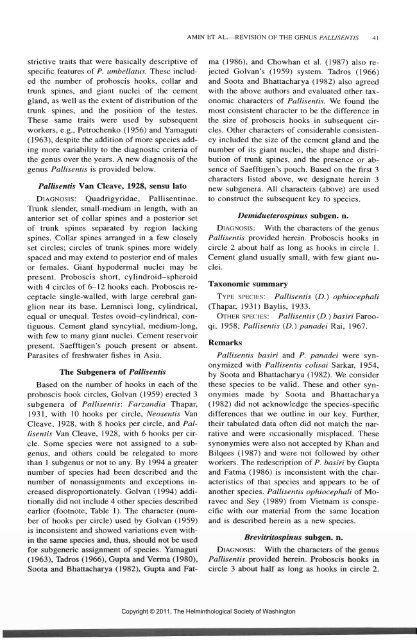Comparative Parasitology 67(1) 2000 - Peru State College
Comparative Parasitology 67(1) 2000 - Peru State College
Comparative Parasitology 67(1) 2000 - Peru State College
You also want an ePaper? Increase the reach of your titles
YUMPU automatically turns print PDFs into web optimized ePapers that Google loves.
strictive traits that were basically descriptive of<br />
specific features of P. umbellatus. These included<br />
the number of proboscis hooks, collar and<br />
trunk spines, and giant nuclei of the cement<br />
gland, as well as the extent of distribution of the<br />
trunk spines, and the position of the testes.<br />
These same traits were used by subsequent<br />
workers, e.g., Petrochenko (1956) and Yamaguti<br />
(1963), despite the addition of more species adding<br />
more variability to the diagnostic criteria of<br />
the genus over the years. A new diagnosis of the<br />
genus Pallisentis is provided below.<br />
Pallisentis Van Cleave, 1928, sensu lato<br />
DIAGNOSIS: Quadrigyridae, Pallisentinae.<br />
Trunk slender, small-medium in length, with an<br />
anterior set of collar spines and a posterior set<br />
of trunk spines separated by region lacking<br />
spines. Collar spines arranged in a few closely<br />
set circles; circles of trunk spines more widely<br />
spaced and may extend to posterior end of males<br />
or females. Giant hypodermal nuclei may be<br />
present. Proboscis short, cylindroid-spheroid<br />
with 4 circles of 6-12 hooks each. Proboscis receptacle<br />
single-walled, with large cerebral ganglion<br />
near its base. Lemnisci long, cylindrical,<br />
equal or unequal. Testes ovoid-cylindrical, contiguous.<br />
Cement gland syncytial, medium-long,<br />
with few to many giant nuclei. Cement reservoir<br />
present. Saefftigen's pouch present or absent.<br />
Parasites of freshwater fishes in Asia.<br />
The Subgenera of Pallisentis<br />
Based on the number of hooks in each of the<br />
proboscis hook circles, Golvan (1959) erected 3<br />
subgenera of Pallisentis: Farzandia Thapar,<br />
1931, with 10 hooks per circle, Neosentis Van<br />
Cleave, 1928, with 8 hooks per circle, and Pallisentis<br />
Van Cleave, 1928, with 6 hooks per circle.<br />
Some species were not assigned to a subgenus,<br />
and others could be relegated to more<br />
than 1 subgenus or not to any. By 1994 a greater<br />
number of species had been described and the<br />
number of nonassignments and exceptions increased<br />
disproportionately. Golvan (1994) additionally<br />
did not include 4 other species described<br />
earlier (footnote, Table 1). The character (number<br />
of hooks per circle) used by Golvan (1959)<br />
is inconsistent and showed variations even within<br />
the same species and, thus, should not be used<br />
for subgeneric assignment of species. Yamaguti<br />
(1963), Tadros (1966), Gupta and Verma (1980),<br />
Soota and Bhattacharya (1982), Gupta and Fat-<br />
AMIN ET AL.—REVISION OF THE GENUS PALLISENTIS 41<br />
ma (1986), and Chowhan et al. (1987) also rejected<br />
Golvan's (1959) system. Tadros (1966)<br />
and Soota and Bhattacharya (1982) also agreed<br />
with the above authors and evaluated other taxonomic<br />
characters of Pallisentis. We found the<br />
most consistent character to be the difference in<br />
the size of proboscis hooks in subsequent circles.<br />
Other characters of considerable consistency<br />
included the size of the cement gland and the<br />
number of its giant nuclei, the shape and distribution<br />
of trunk spines, and the presence or absence<br />
of Saefftigen's pouch. Based on the first 3<br />
characters listed above, we designate herein 3<br />
new subgenera. All characters (above) are used<br />
to construct the subsequent key to species.<br />
Demidueterospinus subgen. n.<br />
DIAGNOSIS: With the characters of the genus<br />
Pallisentis provided herein. Proboscis hooks in<br />
circle 2 about half as long as hooks in circle 1.<br />
Cement gland usually small, with few giant nuclei.<br />
Taxonomic summary<br />
TYPE SPECIES: Pallisentis (D.) ophiocephali<br />
(Thapar, 1931) Baylis, 1933.<br />
OTHER SPECIES: Pallisentis (£>.) basiri Farooqi,<br />
1958; Pallisentis (£>.) panadei Rai, 19<strong>67</strong>.<br />
Remarks<br />
Pallisentis basiri and P. panadei were synonymized<br />
with Pallisentis colisai Sarkar, 1954,<br />
by Soota and Bhattacharya (1982). We consider<br />
these species to be valid. These and other synonymies<br />
made by Soota and Bhattacharya<br />
(1982) did not acknowledge the species-specific<br />
differences that we outline in our key. Further,<br />
their tabulated data often did not match the narrative<br />
and were occasionally misplaced. These<br />
synonymies were also not accepted by Khan and<br />
Bilqees (1987) and were not followed by other<br />
workers. The redescription of P. basiri by Gupta<br />
and Fatma (1986) is inconsistent with the characteristics<br />
of that species and appears to be of<br />
another species. Pallisentis ophiocephali of Moravec<br />
and Sey (1989) from Vietnam is conspecific<br />
with our material from the same location<br />
and is described herein as a new species.<br />
Brevitritospinus subgen. n.<br />
DIAGNOSIS: With the characters of the genus<br />
Pallisentis provided herein. Proboscis hooks in<br />
circle 3 about half as long as hooks in circle 2.<br />
Copyright © 2011, The Helminthological Society of Washington
















